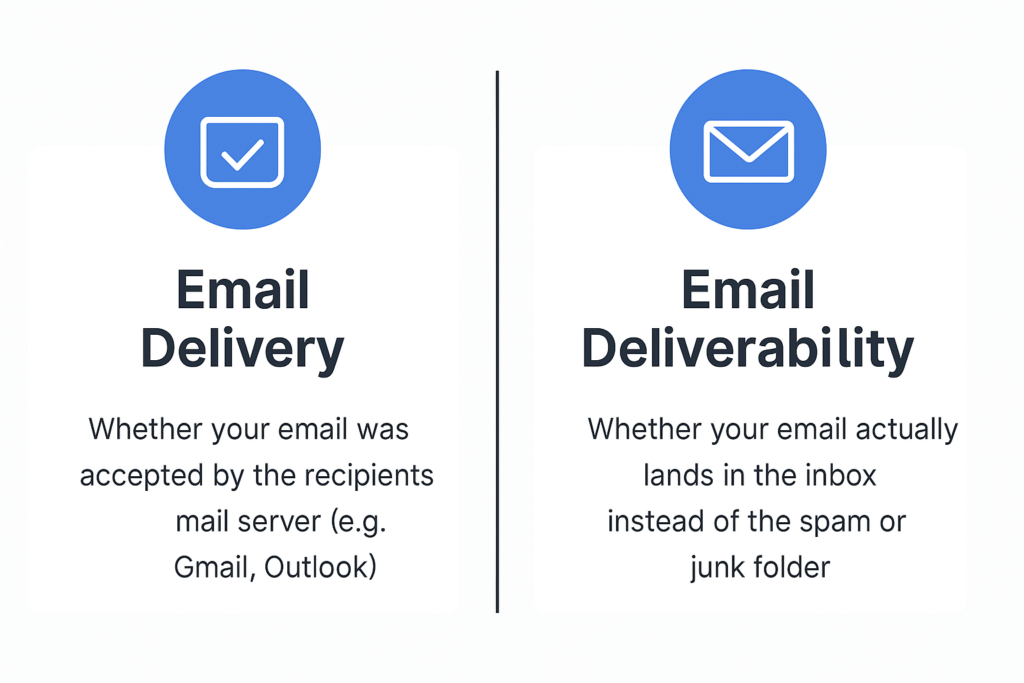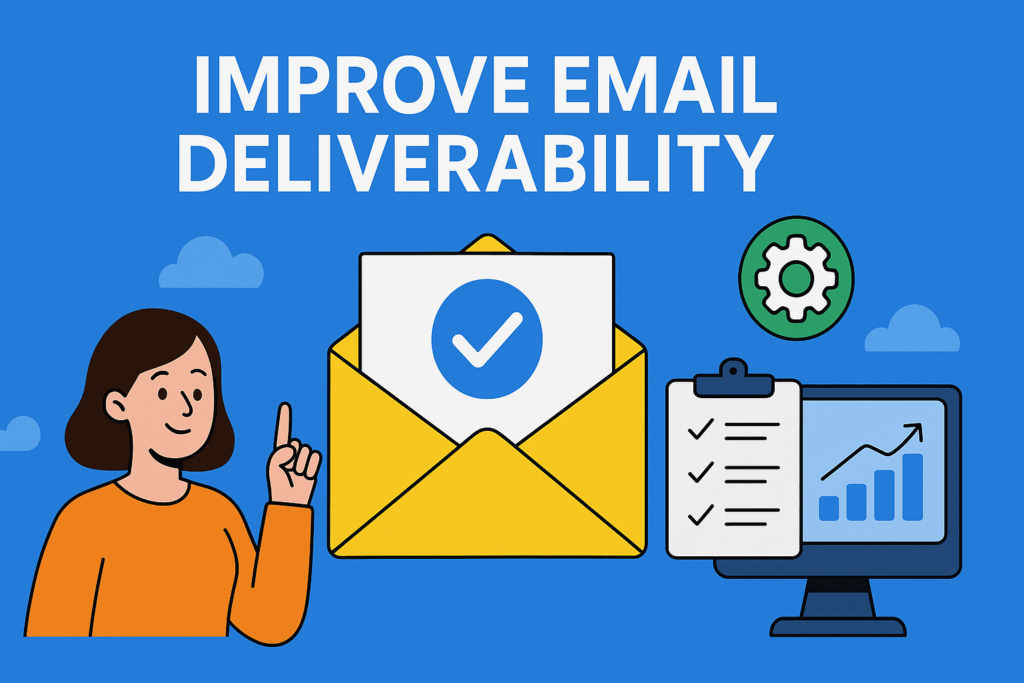Reach the inbox, not the spam folder 🚀
Introduction
Imagine this: You've spent hours crafting the perfect email campaign. It's personalized, beautifully designed, and packed with value. But there's a problem — most of your emails never make it to your audience's inbox. Frustrating, right?
That's why learning how to improve email deliverability is critical for marketers, business owners, and anyone relying on email to drive results.
It is the hidden hero of your email marketing success. It determines whether your emails land in your recipient's inbox or vanish into spam folders. Without solid deliverability, your messages — no matter how brilliant — won't be seen, opened, or acted upon.
📬 Why should you care?
Poor deliverability leads to:
-
Low open rates
-
Missed sales opportunities
-
Damaged sender reputation
-
Wasted time and budget
This guide will walk you through everything you need to know about improving email deliverability — from the techy bits like SPF and DKIM to smart sending strategies and content tips. Whether you're a startup or scaling enterprise, these tactics will help you stay in the inbox and out of trouble.
What Is Email Deliverability? 📈
Before you start tweaking subject lines or switching platforms, it's important to understand what email deliverability really means — and how it's different from just email delivery.
Here's the deal:
-
An email can be successfully “delivered†but still end up in spam.
-
That's why measuring just delivery rates isn't enough.
📊 Why Deliverability Matters
Strong deliverability means your emails:
-
Reach real inboxes, not spam folders 📨
-
Get seen and opened by your audience
-
Drive higher ROI from your email marketing efforts
And here's the kicker: even if you're using the best email marketing platform in the world, your deliverability can still tank without the right strategy.
If you're experiencing:
-
Sudden drops in open rates
-
Higher bounce rates
-
Increased spam complaints
Then it's time to audit and improve your deliverability tactics — which we'll dive into next.
Â

Key Factors That Impact Email Deliverability 🧩
You might be using a great subject line or designing beautiful templates — but if your emails still end up in spam, the issue likely runs deeper. Deliverability depends on a combination of technical setups, sending behavior, and content strategy.
Let's break down the core factors that influence whether your email lands in the inbox or disappears into oblivion:
📛 1. Sender Reputation
Your sender reputation is like your email credit score. Internet Service Providers (ISPs) use it to decide whether they can trust you.
Key things that shape your sender reputation:
-
Spam complaints 🙅â€â™‚ï¸
-
Bounce rates 📉
-
Engagement metrics (opens, clicks, unsubscribes) 📬
-
Sending history and consistency 📆
🔠2. Email Authentication (SPF, DKIM, DMARC)
Authentication helps prove that your email is really coming from you — not a spammer impersonating you. These protocols protect your brand and boost your inbox placement.
Protocol Purpose How It Helps SPF Validates sending IP Prevents spoofing DKIM Verifies email content integrity Builds trust with ISPs DMARC Aligns SPF/DKIM & instructs ISPs Reduces fraud, improves deliverability
📜 3. List Hygiene
Sending to old, unengaged, or invalid email addresses? That's a quick way to damage your deliverability. Keeping a clean list is non-negotiable.
Best practices:
-
Remove hard bounces after each campaign
-
Re-engage or remove inactive subscribers
-
Never buy or rent email lists! 🚫
Tools that help:
-
ZeroBounce
-
NeverBounce
-
Clearout
-
Or use integrated tools in CRMs like monday.com
ðŸ'¥ 4. Content and Design Quality
Yes, ISPs do look inside your emails — and what they find matters. The wrong structure or wording can flag your message as spam.
Things to watch out for:
-
Overuse of salesy or spammy language (e.g. “Act now!â€, “FREEâ€, “Click hereâ€)
-
All-caps subject lines 😬
-
Too many images vs. text
-
Lack of plain-text version
💬 Keep it human, valuable, and clear.
📡 5. Sending Frequency & Volume
Sending too often? Not often enough? Either one can hurt you. ISPs like predictable, healthy sending behavior.
Tips:
-
Keep a consistent schedule
-
Avoid sending massive volumes out of the blue
-
Warm up new IPs and domains slowly
If you're starting a new campaign or switching platforms, use a gradual send ramp-up. Tools like Mailwarm or Instantly can automate the process.

Top 10 Actionable Strategies to Improve Your Email Deliverability 🚀
You now know what affects email deliverability — but how do you fix it? Below are 10 powerful, real-world strategies you can implement right now to boost your inbox placement, improve engagement, and protect your sender reputation.
These tips are used by top email marketers and SaaS platforms, and they'll work for you too.
1. Authenticate Your Emails with SPF, DKIM, and DMARC ðŸ”
If you haven't set up SPF, DKIM, and DMARC yet, you're leaving your reputation (and your subscribers) vulnerable. These authentication protocols help prove that your emails are legitimate — and not from a spammer impersonating your domain.
💡 If you're using platforms like Klaviyo, Campaigner, or Brevo, they often provide easy-to-follow guides or built-in tools for setting these up.
2. Use a High-Quality Email Marketing Platform 🛠ï¸
Your choice of email platform directly impacts deliverability. Great platforms offer built-in tools for:
-
Authentication setup
-
List management
-
Deliverability testing
-
Engagement tracking
Some of the best email marketing platforms for deliverability include:
-
Klaviyo (great automation and predictive analytics)
👉 Want more options? Check our guide on the best email marketing tools.
3. Clean Your Email List Regularly 🧹
You can't maintain high deliverability with a dirty list full of inactive, invalid, or unverified emails.
How to clean it:
-
Remove hard bounces automatically
-
Segment out or re-engage dormant users
-
Use tools like NeverBounce or ZeroBounce for verification
Most modern ESPs (like Brevo) let you automate list hygiene through workflows or rules.
4. Segment Your Subscribers 🎯
A one-size-fits-all email strategy is a fast track to low engagement and high spam complaints.
Smart segmentation helps you:
-
Target the right audience with relevant content
-
Improve open and click rates
-
Reduce unsubscribes and complaints
Platforms like Klaviyo and ActiveCampaign excel in smart segmentation and behavior-triggered messaging.
5. Avoid Spam Triggers in Your Email Content âš ï¸
Even if you mean well, certain content choices can flag your emails as spam.
Avoid:
-
Overuse of CAPS or exclamation marks!!!
-
Spammy phrases like “Buy nowâ€, “Free moneyâ€, “Risk-freeâ€
-
Excessive use of images vs. text
-
Hidden or missing unsubscribe links
Pro Tip: Test your emails with tools like Mail-Tester.com before sending.
6. Implement a Double Opt-In Process ✅
A double opt-in asks subscribers to confirm their email before being added to your list — and it's one of the most effective ways to protect your deliverability.
Benefits:
-
Verifies the email address is valid
-
Confirms genuine interest
-
Reduces spam complaints and bounces
Many platforms — including Moosend and Klaviyo — support this out of the box.
7. Send from a Custom Domain (Not a Free Email) 💼
Emails sent from yourname@gmail.com or info@yahoo.com instantly look suspicious to spam filters. Always send from a verified custom domain (like newsletter@yourcompany.com).
This also allows you to:
-
Set up SPF/DKIM/DMARC
-
Improve your brand's trust and recognition
-
Prevent spoofing
You can do this via your domain registrar or DNS provider, and connect it easily with providers like Campaigner or Brevo.
8. Monitor Engagement Metrics 📊
ISPs look closely at engagement signals. If people regularly open, click, and engage with your emails, you're more likely to be seen as a trustworthy sender.
Track and optimize:
-
Open rates 📬
-
Click-through rates (CTR) 🔗
-
Spam complaint rate 🚫
-
Unsubscribe rate
Use this data to clean your list and refine your campaigns. Platforms like Mailchimp and ActiveCampaign offer excellent analytics dashboards.
9. Make It Easy to Unsubscribe 👋
This sounds counterintuitive, but it actually helps deliverability. If users can't find your unsubscribe link, they'll just hit the spam button.
Best practices:
-
Use clear, visible unsubscribe links
-
Avoid dark patterns or hidden text
-
Offer a preference center for lower opt-out rates
Bonus: Transparent practices build long-term trust with your audience.
10. Warm Up New IP Addresses and Domains 🔥
If you're sending from a new IP or domain, ISPs don't know you yet. Start slow to build a reputation.
How to do it:
-
Start with small batches of highly engaged contacts
-
Gradually increase volume over 2–4 weeks
-
Monitor results and adjust your pace
Services like Mailwarm, Lemwarm, or Instantly can automate this for you.
Common Mistakes That Hurt Email Deliverability âŒ
Even if you're following best practices, a few common missteps can quickly sabotage your sender reputation. These mistakes often go unnoticed — until your open rates drop or emails start bouncing back.
Let's break down the most critical ones you need to avoid:
🚫 1. Buying or Renting Email Lists
This is the fastest way to get blacklisted.
Why it's bad:
-
Most recipients never opted in
-
High bounce rates
-
More spam complaints
-
Violates laws like GDPR and CAN-SPAM
Stick to organic growth. Tools like Brevo and Klaviyo help create signup forms and automations to build your list the right way.
📉 2. Ignoring Bounce and Spam Reports
Hard bounces, soft bounces, and spam complaints are early warning signs. If you ignore them, you risk long-term deliverability damage.
👉 Review reports after each campaign and clean up your list accordingly.
📆 3. Inconsistent Sending Schedule
Sending emails once a month, then blasting five in a week, can confuse both your audience and ISPs.
-
Set a predictable cadence (e.g. weekly, bi-weekly)
-
Avoid email “droughts†followed by floods
-
Use automation to maintain consistency
📣 4. Misleading Subject Lines
Clickbait-style subject lines might boost opens temporarily — but they'll increase spam complaints over time.
Examples to avoid:
-
“Re: your invoice†(when it's not)
-
“You won!†(if there's no prize)
-
“Important account update†(when it's a promo)
ðŸ'» 5. Not Optimizing for Mobile Devices
Over 50% of emails are opened on mobile. If your layout breaks or text is too small, users may delete your message or mark it as spam.
Quick wins:
-
Use responsive templates
-
Test emails on mobile devices
-
Keep your CTA buttons large and tappable
🧾 Summary Table of Common Mistakes:
| Mistake | Why It Hurts | What to Do Instead |
|---|---|---|
| Buying Email Lists | Leads to high bounces and spam reports | Grow your list organically with opt-in forms |
| Ignoring Bounce/Spam Reports | Damages sender reputation over time | Clean your list after every campaign |
| Inconsistent Sending Schedule | Signals untrustworthy behavior to ISPs | Maintain a steady email cadence |
| Clickbait Subject Lines | Increases spam complaints and unsubscribes | Use transparent and relevant subject lines |
| Unoptimized Mobile Layouts | Decreases engagement, boosts spam flags | Use responsive design and mobile-friendly content |
Conclusion: Deliver More, Stress Less 📩
Improving email deliverability isn't just a technical task — it's a strategic advantage. Every email that hits the inbox gives you a shot at engaging a customer, making a sale, or nurturing loyalty.
Here's a quick recap of what you've learned:
✅ Email deliverability is different from email delivery — and far more important
✅ Your reputation, list hygiene, content, and frequency all play a part
✅ Using a trusted email marketing platform like Klaviyo, Brevo, or Campaigner makes a real difference
✅ Avoiding common mistakes and applying best practices can dramatically increase your inbox placement
Your next step?
Start with an audit. Review your email setup, scrub your list, implement authentication, and refine your strategy using the 10 tactics we've covered. Email success isn't just about sending more — it's about sending smarter. 💡
FAQs: Email Deliverability Answered â“
1. What is a good email deliverability rate?
A strong deliverability rate is typically 95% or higher. Anything below 90% suggests issues with list hygiene, reputation, or infrastructure.
2. How can I tell if my emails are going to spam?
Use tools like Mail-Tester.com, GlockApps, or Mailtrap to test your inbox placement. Also, check engagement metrics — sudden drops in open rates are a red flag.
3. Is SPF, DKIM, and DMARC setup really necessary?
Absolutely. These protocols authenticate your emails, reduce spoofing, and boost your deliverability. Most modern ESPs guide you through setup easily.
4. What causes a high bounce rate?
Common reasons include:
-
Invalid or outdated email addresses
-
Purchased or unverified lists
-
Typos in user signups
Regular list cleaning helps prevent this.
5. Should I use double opt-in?
Yes! Double opt-in ensures you're sending to real, interested subscribers. It improves list quality and drastically reduces spam complaints.
6. What happens if I send emails too frequently?
Over-sending can lead to:
-
Higher unsubscribe rates
-
More spam complaints
-
Fatigue among your audience
Stick to a consistent, value-driven schedule.
7. How can I warm up a new domain or IP address?
Start by sending to small segments of your most engaged users, then gradually increase volume over 2–4 weeks. Use tools like Mailwarm or Instantly to automate this.
8. Do emojis or images affect email deliverability?
Moderately. One or two emojis are fine — just don't overdo it. Balance your design: too many images without enough text may trigger spam filters.
9. What's the best email platform for improving deliverability?
Top choices include:
-
Klaviyo – robust automation & segmentation
-
Brevo – excellent deliverability tools & pricing
-
Campaigner – advanced features + AI content tools
See more in our best email marketing tools guide.
10. Is it bad to remove inactive users from my list?
Not at all — it's actually one of the best things you can do for deliverability. Removing disengaged users helps improve your sender reputation and inbox placement.

